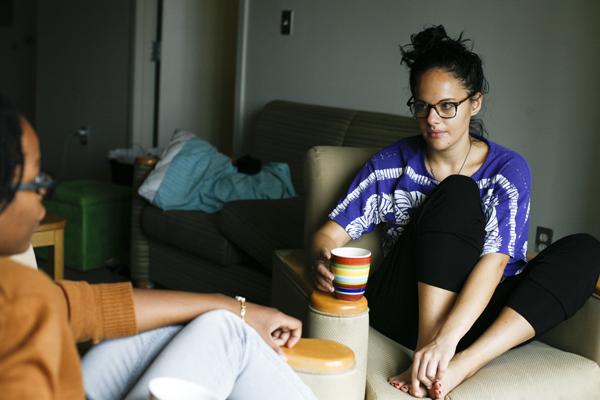Sophomore Dymond Redd has too many bad memories about her first semester at GW.
She arrived on campus as a transfer student from Arcadia University last spring, just a week after receiving her acceptance letter. She spent the semester commuting from Maryland, struggling to connect with students and find the campus pulse.
“It was very, very hard,” Redd said. “The final couple of weeks, when I was like, ‘Just make it, just make it.’ There’s so much going on that you don’t know about if you’re not living on campus.”
This semester, Redd is living on campus and said she no longer feels so disconnected. She’s now one of 16 mentors helping new transfer students get acclimated to GW faster than she did.
A year after launching the mentorship program, officials with the Center for Student Engagement believe they’ve finally found the right approach to welcome transfer students to campus.
The program is the latest effort to reach out to transfer students who enter GW more abruptly than their peers and often struggle to integrate with others in their class year. Last year, 342 college students transferred to GW and 496 transfer students returned for another year at GW.
Over the last two years, GW has tried a string of new approaches for helping transfers. The University tried housing transfer students together on the Mount Vernon Campus, before shifting the community over to a residence hall in Foggy Bottom and then, most recently, placing most incoming transfers in Mitchell Hall, which also houses non-transfer students.
Redd said she wants to make sure students don’t miss out on what she craved last semester – someone to talk to about classes, give advice about joining student organizations and help connect her to campus and D.C. events.
And the mentoring program seems to be catching on: Five of this year’s 16 mentors were participants themselves last year, which Associate Dean of Students Tim Miller called a testament to the program’s success.
“I think one of the reasons why this is different and more successful than other things that have happened in the past is because it [fits] both interests: ‘I want someone to help me and I want to help others,’” Miller said.
Meeting the expectations of transfer students is difficult because each student comes from a different background, he said.
They also send mixed messages. A CSE survey last year found that four out of five transfer students said they wanted to be a part of a transfer student community, but did not want to be labeled as transfer students.
“What we learned about transfers is, they want to be transfers in the orientation phase and then they want you to treat them like everybody else,” he said. “Once they’re here, they’re always going to be a transfer, but at some point they just want to be a junior.”
But some students, like junior Xunaxi Henao, never felt like they needed a mentor to find their place on campus. A biology major who transferred from Pasadena Community College, Henao said she found her niche through classes at GW.
About 57 percent of GW’s roughly 900 transfer students came to GW after studying at a community college, according to the University’s survey.
GW has made some tweaks to the program. Realizing that not every transfer student wants the mentorship experience, students will opt into the program next semester instead of being assigned a mentor.
Katie Strickberger, a junior in the GW School of Business, said she regularly meets with five students out of the 15 she was assigned. Next semester, mentors will likely be paired with two to three incoming transfer students to make the experience more intimate and personal.
“I started when the program started and stuck through it because I see that there are a lot of transfer students who don’t need it, and are fine and choose not to participate, but there are ones who take advantage of it and you can see that you make a difference,” she said.







